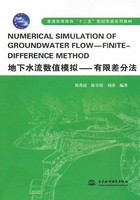
Chapter 1 Introduction
§1.1 Brief of Groundwater
Groundwater is the most precious natural resources for a country.Throughout history,people around the world have used groundwater as a source of drinking water and even today,more than half of the world's population depend on groundwater for survival.Many countries have relied on groundwater for generations,with little thought of using it up or contaminating it.All countries hope to improve their economy by increasing industrial or agricultural production.This goal results in an increase in water use and the potential for contamination.Water managers once believed groundwater was a pure resource,isolated from sources of contamination.However,groundwater contamination has emerged as a major environmental problem in many countries.The public's attention has been drawn to the problem because of the many incidents of groundwater contamination.In the United States,this situation has led to expensive groundwater cleanup,the establishment of groundwater protection laws and environmental protection programs.
1.1.1 Importance of Groundwater
Water is vital to man's existence.Early human civilization was centered around springs and streams.The waterhole was the forerunner of a well.Early man copied animals and found that water could be obtained by digging cavities in wadi beds or damp places.
Hidden beneath much of the land surface are groundwater reservoirs-open spaces or voids in rocks which store the largest volume of liquid freshwater on Earth.More than 20 percent of Earth's freshwater resources are here.It is the source of drinking water for most of the world's rural population and is a vital resources,especially in arid areas and on islands,where it may be the only source for potable water.It is essential to maintain soil moisture for crops,lake levels,streamflow,and wetlands.Groundwater from wells and springs is the major source of bottled mineral drinking water.
Groundwater is present in permeable rocks beneath most land areas.Where it occurs,it should be considered a possible alternative supply to surface water.As a water supply,groundwater has the following potential advantages.
(1)Compared with the high costs of constructing surface water reservoirs,the drillings of wells is relatively inexpensive and can be phased in over a period of specified time to meet increasing demand.
(2)The environmental impact of a well is minor.
(3)Many aquifers have large storage capacities so that increasing demand for water during extended droughts can be met more easily.
(4)Groundwater is usually of good chemical and bacterial quality and is unlikely to require treatment other than precautionary chlorination.
Contrary to commonly-held belief,groundwater is a renewable resource.In many parts of the world,groundwater supplies are continually replaced by rainfall and ensuing infiltration although in arid and semiarid regions,the recover rate may be slow or periodic and the recover amount is small.It is important to realize that all artificial withdrawal of groundwater is at the expense of natural discharge.By careful and knowledgeable management,however,the effects of pumping can be controlled to minimize adverse environmental consequences.In the long term,water levels will only decline if groundwater withdrawals exceed the local rates of replenishment.This custom,called groundwater“mining”,is more likely to occur in semiarid regions with limited or no replenishment.
1.1.2 Groundwater Resources Management
Groundwater is a renewable resource,Therefore,in order to achieve long-term benefits,not only the sufficient assessment of groundwater potential but also the high efficiency of water use is required.There are many countries in the world where groundwater is one of the major sources of drinking water.With the increasing development of the groundwater resources and the growing impacts of human activities on the aquifers,problems such as declines of groundwater heads and deterioration of groundwater quality have been observed in many places in last decades.Sustainable development strategy and integrated groundwater resources management must be developed and implemented to guarantee the right of use of the limited water resources for our future generations.
To formulate technically reasonable groundwater resources management polices,decision makers always ask questions like:
(1)How long can an aquifer maintain the current rate of groundwater abstraction?What is the safety yield that the aquifer can sustain the continuous abstraction?
(2)What is the capture zone of a water supply well field?What is the most likely pathway of contaminants from domestic wastewater and leaches from solid waste disposal sites?What are the chances that the pollutants from those sources would arrive at water supply wells?And how long it takes?In order to protect the well fields from pollution,a protection zone should be delineated.What is the size of the protection zone?
Providing answers to these questions involves the understanding of the behavior of groundwater flow system and the prediction of the system's response to any stresses.Numerical simulation,a useful tool for groundwater management and protection,is always used in solving these problems.Understanding of groundwater system characteristics is the precondition of building mathematical model.The groundwater flow problems and the groundwater quality problems can be solved efficiently by numerical simulation.In order to quantitatively calculate the available exploitation quantity of groundwater and provide basis for rational development and utilization of water resource,the numerical simulation method is used to establish a three-dimensional numerical simula tion model.An optimal scheme is determined to ensure the normal operation of the water source.